Articulating booms: Market trends drive innovation
29 August 2024
Articulating booms have long been well-established across North American jobsites. But market demands and industry trends could soon very well see these versatile lifts undergo changes. Lindsey Anderson reports.
“Rather than seeing articulating booms being used in new applications, instead what we are seeing in North America is continuing expansion of their popularity,” says Dominik Damm, Genie’s global product director, booms. “That’s because experienced operators realize the efficiencies to be gained from using an articulating boom, so they’re choosing articulating lifts over telescopic booms for certain jobs.”
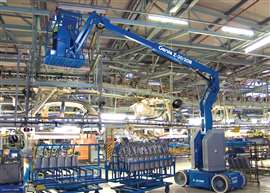 Genie sees the biggest opportunities for development and change within in the areas of technology and accessories for articulating booms, it says. (Photo: Genie)
Genie sees the biggest opportunities for development and change within in the areas of technology and accessories for articulating booms, it says. (Photo: Genie)
Damm makes a major point: In addition to their ability to reach up, over and out, an articulating boom’s primary and secondary boom lifts create a parallelogram that allows operators to move up and down while staying on the same flat plane. This allows operators to reach a greater area, vertically, without having to position the boom when compared to a telescopic boom, which would require them to drive back and forth to get to the same point.
Connor Stanmore, JCB’s product manager, agrees.
“Articulating booms come into their own when being utilized in small spaces where agility is required,” Stanmore says. “They offer low tail swing and a tight turning radius. [Plus,] up-and-over specifications still remain a key point of consideration when looking to purchase a boom lift.”
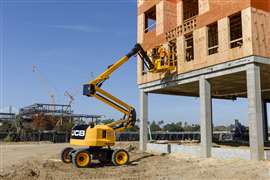 JCB will be focusing on site safety, operational efficiency and digital transformations for articulating booms in the future, it says. (Photo: JCB)
JCB will be focusing on site safety, operational efficiency and digital transformations for articulating booms in the future, it says. (Photo: JCB)
But have the market applications for these flexible lifts changed over the last handful of years? Yes – and no.
“We see articulated boom lifts being used more and more in congested work zones, like in urban areas and city centers and space-restricted facilities like warehouses that require operators to access to multiple angles and reach in order to complete work at height,” says Nate Hoover, director of product management, JLG. “We also see increased use of these machines on concrete jobsites, as a staple in tilt-up wall construction. These walls are typically set in place using a crane, and operators in a boom lift are positioned to remove bracing when needed. Articulated boom lifts can also be used to secure extra anchors when attaching walls together, where applicable.”
To get a feel for the current market, trends, future applications and machine design updates
ALH asked manufacturers for their take. Here’s what they had to say.
Applications for articulating booms have long been well-established in North America. Has this changed at all? Are articulating booms being utilized in any new ways/applications?
Malcolm Early, VP Marketing, Skyjack: Moving forward, capacity increases look to be a key trend in the articulating boom market to optimize productivity and facilitate ease of workflow. Having a range with increased capacities means that operators are able to complete tasks more efficiently across all kinds of applications.
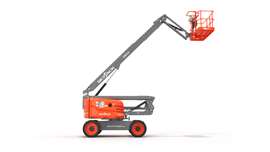 Skyjack says capacity increases seem to be a key trend in the articulating boom market in order to optimize productivity and facilitate ease of workflow. (Photo: Skyjack)
Skyjack says capacity increases seem to be a key trend in the articulating boom market in order to optimize productivity and facilitate ease of workflow. (Photo: Skyjack)
Furthermore, integration with telematics systems with respect to insights into efficiencies and optimization have become increasingly popular.
Connor Stanmore, Product Manager, JCB: Articulating booms are becoming increasingly used in media applications due to their huge versatility. They can provide flexible camera angles and perspectives that would be nearly impossible to capture with traditional equipment. Sweeping camera shots and aerial images can all be achieved through ever-increasing basket capacities across the market. Beyond their direct filming application on set, they can also be rigged up for lighting set-ups and special effects, really showcasing themselves as the true star of the show for versatility.
Nate Hoover, Director of Product Management, JLG: Traditionally, the steel erection industry has favored straight booms over articulated booms because of their simple controls and high capacity. But, that’s changing. Ironworkers now also use articulated boom lifts on steel erection projects when crews need to do interior building work, such as between ceiling beams or adjacent floors. Because steel joists and X-beams used in steel buildings are typically only a few feet apart, articulated boom lifts help equipment operators get into small, challenging spaces that are otherwise inaccessible.
The electrification of articulated boom lifts also opens up opportunities for new uses/applications in environmentally sensitive work zones, including data centers, hospitals and laboratories, where IC machines are not permitted.
Sinoboom North America: Articulated booms are increasingly being adopted in the entertainment industry, particularly for setting up lighting, cameras, and other film equipment at elevated positions. Sinoboom’s excellent rough terrain performance makes it ideal for both smooth off-road and quiet indoor and outdoor operation. This is crucial for film sets where mobility and minimal noise are essential.
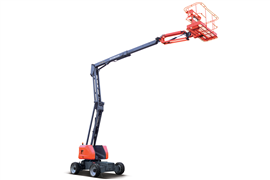 <Sinoboom.jpg> In the coming years, Sinoboom says, the market will see more hybrid and electric models, higher working heights and advanced safety features. (Photo: Sinoboom North America)
<Sinoboom.jpg> In the coming years, Sinoboom says, the market will see more hybrid and electric models, higher working heights and advanced safety features. (Photo: Sinoboom North America)
In Southern California, for example, the film industry utilizes stick booms with 1,000 pounds of platform capacities to manage lighting and large fly swatters—large aluminum frames with shade cloth to block the sun. These booms, often painted flat black and equipped with cable rollers, ensure that cables do not interfere with the camera’s view. Our articulating booms, AB520EJ Plus, with 4WD and 40 percent gradeability and a standard active oscillating function, offer the stability and maneuverability needed for such demanding tasks.
What is current market demand like for articulating booms in North America? What sectors/markets are performing well? What size-class is outperforming others? Why?
Gary Crook, VP Of Engineering, MEC Aerial Work Platforms: From our perspective, the 85-foot class is buoyant. This is a combination of the large projects all over the country and the innovative DualReach 85-J Boom recently introduced by MEC that is two machines in one.
DAMM: We’re seeing continued strong demand in North America for our boom lifts, including articulated booms. This is a result of continued investments in industries related to infrastructure, strong rental utilization, and the replacement cycle.
In terms of popular articulated boom models, booms in the sub-50-foot height class continue to be some of the most popular articulating boom models. Historically, above 50 feet is where customers begin relying on straight stick booms for their needs. At the same time, we’re excited to see demand growing for articulating booms in the larger height classes as well.
We’re also seeing a continued trend related to electrification with strong demand for hybrid and electric articulated booms in North America.
At Genie, this trend isn’t surprising. Genie FE hybrid articulating boom lifts have been the top performers in the electrified, articulating boom class for some time. They’re extremely versatile, because they can work indoors without any noise or emissions in electric mode, while offering the ability to work in hybrid mode as well. They’re also a good choice for jobsites concerned with reducing emissions or hitting sustainability targets. FE boom lifts can work in electric mode, without emissions, for a full workday on a single charge. They can also work a full work week on a single tank of fuel in hybrid mode. In addition to this, Genie FE can recharge the machine’s battery while operating in hybrid mode, which is helpful if charging infrastructure is limited or non-existent. And, the machine also can start from a flat battery if someone forgets to plug it in at the end of the workday.
EARLY: Generally speaking, the market for booms has been positive for 2024 and it’s looking to continue to be positive with year-over-year growth. Much of the growth of booms is coming off the back of rental companies that operate in oil states. We are also seeing increased activity in the building of factories and assembly plants as onshoring and nearshoring has become a post-Covid reaction to general industry supply chain issues.
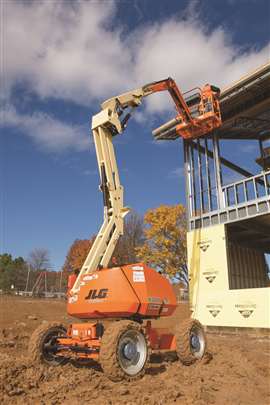 JLG anticipates the electrification of articulating boom lifts to accelerate in the coming years. (Photo: JLG)
JLG anticipates the electrification of articulating boom lifts to accelerate in the coming years. (Photo: JLG)
HOOVER: With a greater need in urban environments for the versatility these machines offer, we continue to see strong demand for articulated boom lifts of all size classes and all power options (electric, hybrid and fuel) in North America. Sustained market demand for these models is also being driven by replacement cycles, fleet growth, and ongoing construction and construction-related activities, not only in North America but all around the globe.
Demand does vary by region, but despite regional differences, there are some common themes. There is a large focus on productivity and enabling equipment users to do more with less, in tighter spaces, under stringent time and budget demands in a manner that is minimally disruptive to the environment.
The 60- to 80-foot size classes are the largest volume of these machines in the market. These models offer the right mix of up-and-over capability and outward reach to work that fits in typical building construction, which is usually between 3-10 stories high (the average is six stories). For example, on a 33-foot-high warehouse, a 60-foot articulated boom allows operators to go up 30-foot and out 30-foot to get the height and radius needed to get work done. On a 4-5 story facility, the outer envelope of an 80-foot articulated boom lift enables operators to access those higher heights without needing a heavier machine.
With these trends in play, we anticipate the demand for articulated boom lifts to remain high for the foreseeable future. There is plenty of work to do right now, and despite signs that the economy is normalizing to pre-pandemic levels, there are no signs of it slowing down.
SINOBOOM NORTH AMERICA: Based on AEM data, the demand for articulated boom lifts in North America is rising, driven by growth in the construction and industrial maintenance sectors. Electric articulated booms increased from 2.6 percent in 2022 to 3.1 percent in 2023, and diesel booms from 4.8 to 5.7 percent. The 40- to 50-foot size is particularly outperforming, with significant growth due to its versatility and efficiency. This trend reflects the need for safe, advanced equipment in complex environments and is supported by ongoing infrastructure and commercial projects.
STANMORE: Market demand for articulating boom lifts is expected to stay high given the continued investments made through the infrastructure bill. Many manufacturers have been clearing through their post-pandemic backlog by increasing global manufacturing capacities - A testament to the continued demand for these products. Market dynamics and application of these machines remains largely the same with use coming predominantly from urban areas where a small footprint and up and over capabilities are required.
What changes, if any, will we be seeing come to the articulating boom lift market in the coming year(s)?
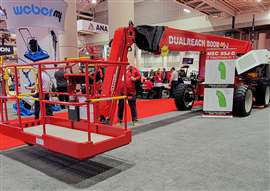 MEC’s DualReach, seen here, is a new development introduced by MEC within the articulating boom lift market. (Photo: MEC Aerial Work Platforms)
MEC’s DualReach, seen here, is a new development introduced by MEC within the articulating boom lift market. (Photo: MEC Aerial Work Platforms)
CROOK: DualReach is a new development introduced by MEC within the articulating boom lift market. This patent pending innovation allows the user to flick a switch and have the machine offer an articulated boom work envelope or to offer the work envelope of a telescopic boom. It solves the industry wide problem of the right mix of both types to meet optimal utilization. The MEC 85-J Boom effectively offers two machines in one by incorporating both up-and-over or straight outreach ability in one model.
DAMM: Where we’re seeing opportunities for development and change are in the areas of technology and accessories. Particularly how we can use technology and accessories to continue enhancing safety for operators. If you look at the auto industry, you’ll already see examples of how technology is being used to enhance safety with features like object sensing and collision avoidance.
And, as we’ve always done, we’re continuing to invest in incremental improvements that enhance the machine’s performance and reliability to increase uptime, lower the total cost of ownership over the life of the boom, and/or result in a higher residual value.
And, of course, it’s likely we’ll see continued development in the area of electrification, especially as advancements are made in battery technology. This is where partnerships, like the one Genie has with battery technology company Acculon, are important. Because battery technology is Acculon’s specialty, working together, Genie and Acculon can make more progress in this area, faster, than either party could do alone. While, of course, ensuring that solutions make sense by providing the performance and reliability needed in addition to reducing the total cost of ownership.
EARLY: The electrification of articulating booms is likely; it hinges on infrastructure and costs in the North American market particularly. In global terms, the move toward electrification in its various forms is more advanced in Europe. In May 2024, Skyjack launched its fully electric SJ45 AJE+ and SJ60 AJE + articulating E-booms. Meanwhile, in North America the customer feedback we have is that there are still some reservations within the rental industry revolving around the infrastructure needs to support that technology.
HOOVER: We anticipate the electrification of articulating boom lifts to accelerate in the coming years. The need for non-fossil fuel-based (hybrid or electrified) equipment is being driven by the increasing use of these machines in urban environments with increasingly stringent regulatory requirements.
Other changes we see coming to the articulated boom lift market are the need for higher-capacity models, for lighter-weight models and for features that allow these machines to work in varying ground conditions, from greenfield and brownfield construction sites to industrial projects and work on slabs. There is also a desire for more simplified controls and machine operation.
SINOBOOM NORTH AMERICA: In the coming years, the market will see more hybrid and electric models, higher working heights, and advanced safety features. Additionally, AI integration will enhance equipment performance and efficiency. The demand for compact designs suitable for urban projects will grow, and the rental market will expand as companies seek flexibility and cost management.
STANMORE: There are three key points that will be of focus in the coming years: Site safety, operational efficiency and digital transformation. While listed as three individual points, digital transformation will be the enabler of enhanced site safety and operational efficiency. Integrating advanced safety features such as complete collision avoidance and refined digital stability control to allow for closer enhanced preventative safety measures. With regards to efficiency, operator programmable semi-autonomous lifts for repetitive tasks would ensure that the quickest routes are being taken to reach the desired location without the need for positioning and re-positioning each time.
For more on this story, including additional takes on the market, how batteries are impacting equipment, and top tips to consider before making a purchase, visit our sister publication, International Rental News.
CONECTAR-SE COM A EQUIPE





